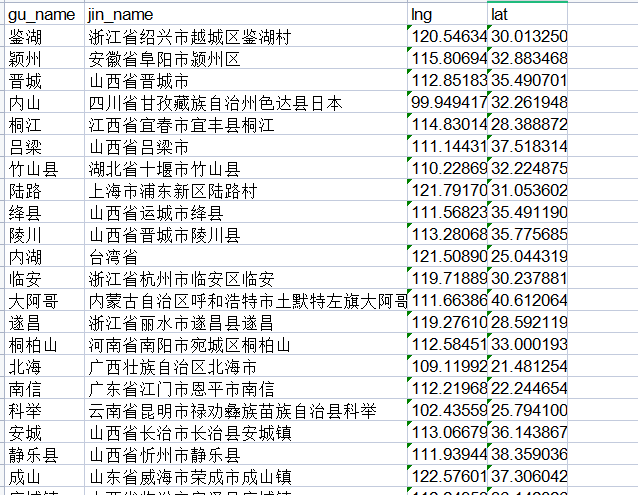地点实体
预处理
对于每个诗人的地点进行处理,只要我们能够识别出经纬度的古今地点,保存已下信息到地点的属性中

代码
import pandas as pd
import numpy as np
import re
from py2neo import Node,Relationship,Graph,NodeMatcher,RelationshipMatcher
# 创建节点
def CreateNode(m_graph,m_label,m_attrs):
#根绝节点name属性,查找节点
m_n="_.name="+"\'"+m_attrs['name']+"\'"
matcher = NodeMatcher(m_graph)
re_value = matcher.match(m_label).where(m_n).first()
#print(re_value)
if re_value is None:
m_mode = Node(m_label,**m_attrs)
n = graph.create(m_mode)
return n
return None
# 查询节点
def MatchNode(m_graph,m_label,m_attrs):
m_n="_.name="+"\'"+m_attrs['name']+"\'"
matcher = NodeMatcher(m_graph)
re_value = matcher.match(m_label).where(m_n).first()
return re_value
# 创建关系
def CreateRelationship(m_graph,m_label1,m_attrs1,m_label2,m_attrs2,m_r_name):
reValue1 = MatchNode(m_graph,m_label1,m_attrs1)
reValue2 = MatchNode(m_graph,m_label2,m_attrs2)
if reValue1 is None or reValue2 is None:
return False
m_r = Relationship(reValue1,m_r_name,reValue2)
n = graph.create(m_r)
return n
#查找关系
def findRelationship(m_graph,m_label1,m_attrs1,m_label2,m_attrs2,m_r_name):
reValue1 = MatchNode(m_graph, m_label1, m_attrs1)
reValue2 = MatchNode(m_graph, m_label2, m_attrs2)
if reValue1 is None or reValue2 is None:
return False
m_r = Relationship(reValue1, m_r_name['name'], reValue2)
return m_r
def updateRelation(m_graph,m_label1,m_attrs1,m_label2,m_attrs2,m_r_name):
reValue1 = MatchNode(m_graph, m_label1, m_attrs1)
reValue2 = MatchNode(m_graph, m_label2, m_attrs2)
if reValue1 is None or reValue2 is None:
return False
print(m_r_name)
propertyes={'value': m_r_name['value'], 'danwei': m_r_name['danwei']}
m_r = Relationship(reValue1, m_r_name['name'], reValue2,**propertyes)
graph.merge(m_r)
#修改节点属性
def updateNode(m_graph,m_label1,m_attrs1,new_attrs):
reValue1 = MatchNode(m_graph, m_label1, m_attrs1)
if reValue1 is None:
return False
reValue1.update(new_attrs)
graph.push(reValue1)
graph = Graph('http://localhost:7474',username='neo4j',password='fengge666')
#获取指定文件夹下的excel
import os
def get_filename(path,filetype): # 输入路径、文件类型例如'.xlsx'
name = []
for root,dirs,files in os.walk(path):
for i in files:
if os.path.splitext(i)[1]==filetype:
name.append(i)
return name # 输出由有后缀的文件名组成的列表
def read_real_where_name():
file='data2/gu_jin_lng_lat.xlsx'
data=pd.read_excel(file)
gu_name=list(data.gu_name)
return gu_name
def read_gu_dict():
file = 'data2/gu_jin_lng_lat.xlsx'
data = pd.read_excel(file)
gu_name = list(data.gu_name)
jin_name=list(data.jin_name)
lng=list(data.lng)
lat=list(data.lat)
gu_dict={}
for i in range(len(gu_name)):
gu=gu_name[i]
gu_dict[gu]={"jin_name":jin_name[i],"lng":lng[i],"lat":lat[i]}
return gu_dict
def read_where(author,file,gu_name):
data=pd.read_excel(file)
wheres=data.wheres
real_where=[]
for i in range(len(wheres)):
where_name=wheres[i]
where_list=where_name.split(',')
for it in where_list:
if it in gu_name and it!='无':
real_where.append(it)
real_where=list(set(real_where))
if len(real_where)!=0:
for it in real_where:
jin=gu_dict[it]['jin_name']
lat=gu_dict[it]['lat']
lng=gu_dict[it]['lng']
attr1 = {"name":it,"jin_name": jin,"lng":lng,"lat":lat}
CreateNode(graph, where_name_label, attr1)
print("创建地点:" + it + "成功!!")
attr2 = {"name": author}
# 创建关系
m_r_name1 = "轨迹"
reValue1 = CreateRelationship(graph, author_label, attr2, where_name_label, attr1, m_r_name1)
print("创建关系:" + author + "-轨迹-" + it + "成功")
if __name__ == '__main__':
file = 'author/'
lists = get_filename(file, '.xlsx')
gu_name = read_real_where_name()
gu_dict = read_gu_dict()
author_label='author'
where_name_label='where_name'
for it in lists:
newfile = file + it
print(newfile)
author = it.split('.')[0]
read_where(author,newfile, gu_name)
展示效果

事件实体
属性
事件属性包括:name为事件全名,时间,地点
其中对于地点要进行处理,只要包含我们有经纬度的真实可标记的地点
代码
import pandas as pd
import numpy as np
import re
from py2neo import Node,Relationship,Graph,NodeMatcher,RelationshipMatcher
# 创建节点
def CreateNode(m_graph,m_label,m_attrs):
#根绝节点name属性,查找节点
m_n="_.name="+"\'"+m_attrs['name']+"\'"
matcher = NodeMatcher(m_graph)
re_value = matcher.match(m_label).where(m_n).first()
#print(re_value)
if re_value is None:
m_mode = Node(m_label,**m_attrs)
n = graph.create(m_mode)
return n
return None
# 查询节点
def MatchNode(m_graph,m_label,m_attrs):
m_n="_.name="+"\'"+m_attrs['name']+"\'"
matcher = NodeMatcher(m_graph)
re_value = matcher.match(m_label).where(m_n).first()
return re_value
# 创建关系
def CreateRelationship(m_graph,m_label1,m_attrs1,m_label2,m_attrs2,m_r_name):
reValue1 = MatchNode(m_graph,m_label1,m_attrs1)
reValue2 = MatchNode(m_graph,m_label2,m_attrs2)
if reValue1 is None or reValue2 is None:
return False
m_r = Relationship(reValue1,m_r_name,reValue2)
n = graph.create(m_r)
return n
#查找关系
def findRelationship(m_graph,m_label1,m_attrs1,m_label2,m_attrs2,m_r_name):
reValue1 = MatchNode(m_graph, m_label1, m_attrs1)
reValue2 = MatchNode(m_graph, m_label2, m_attrs2)
if reValue1 is None or reValue2 is None:
return False
m_r = Relationship(reValue1, m_r_name['name'], reValue2)
return m_r
def updateRelation(m_graph,m_label1,m_attrs1,m_label2,m_attrs2,m_r_name):
reValue1 = MatchNode(m_graph, m_label1, m_attrs1)
reValue2 = MatchNode(m_graph, m_label2, m_attrs2)
if reValue1 is None or reValue2 is None:
return False
print(m_r_name)
propertyes={'value': m_r_name['value'], 'danwei': m_r_name['danwei']}
m_r = Relationship(reValue1, m_r_name['name'], reValue2,**propertyes)
graph.merge(m_r)
#修改节点属性
def updateNode(m_graph,m_label1,m_attrs1,new_attrs):
reValue1 = MatchNode(m_graph, m_label1, m_attrs1)
if reValue1 is None:
return False
reValue1.update(new_attrs)
graph.push(reValue1)
graph = Graph('http://localhost:7474',username='neo4j',password='fengge666')
#获取指定文件夹下的excel
import os
def get_filename(path,filetype): # 输入路径、文件类型例如'.xlsx'
name = []
for root,dirs,files in os.walk(path):
for i in files:
if os.path.splitext(i)[1]==filetype:
name.append(i)
return name # 输出由有后缀的文件名组成的列表
def read_real_where_name():
file='data2/gu_jin_lng_lat.xlsx'
data=pd.read_excel(file)
gu_name=list(data.gu_name)
return gu_name
def read_where(author,file,gu_name):
data=pd.read_excel(file)
date=list(data.data)
where_name=list(data.wheres)
things=list(data.things)
for i in range(len(date)):
#处理地区,满足我们需要的地区条件
where_list=where_name[i].split(',')
for it in where_list:
if it in gu_name and it!='无':
attr1={"name":things[i],"date":date[i],"where_name":where_name[i]}
CreateNode(graph, things_label, attr1)
print("创建事件:" + things[i] + "-成功!!")
attr2 = {"name": author}
# 创建关系
m_r_name1 = "事迹"
reValue1 = CreateRelationship(graph, author_label, attr2, things_label, attr1, m_r_name1)
print("创建关系:" + author + "-事迹-" + things[i] + "-成功")
break
if __name__ == '__main__':
file = 'author/'
lists = get_filename(file, '.xlsx')
gu_name = read_real_where_name()
author_label='author'
things_label='things'
for it in lists:
newfile = file + it
print(newfile)
author = it.split('.')[0]
print(author)
read_where(author,newfile,gu_name)
展示效果
